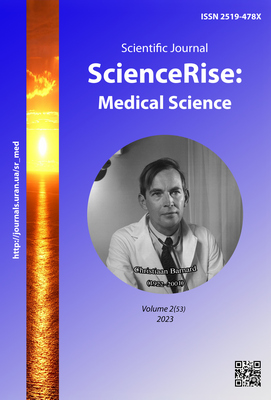Role of EEG and MRI brain in the diagnosis of unprovoked seizures in children in a tertiary care centre
DOI:
https://doi.org/10.15587/2519-4798.2023.283806Keywords:
unprovoked seizures, seizure disorder, seizures, EEG, MRIAbstract
Seizure disorders are a major public health problem in a developing country like India. Epilepsy characterized by recurrent unprovoked seizures is a common heterogeneous neurological problem in children that exerts a significant medical, physical, psychological, social, and economic challenge. This study evaluated the importance of the available diagnostic modalities, EEG and MRI, which could influence the management, prognosis and recurrence of unprovoked seizures.
The aims and objectives: To determine the role of Electroencephalography and MRI BRAIN in evaluating children presenting with unprovoked seizures.
Methodology: The present study was a hospital-based observational study carried out during the period of January 2021 to December 2021 of 70 children who presented with unprovoked seizures to the Department of Paediatrics, Niloufer Hospital, Hyderabad.
Results: Among the 70 children who were investigated, EEG showed abnormal findings in 45 (64.29 %) cases. Out of these, the majority of 32 (45.71 %) cases had generalized seizures, and 13 (18.57 %) cases were focal seizures. MRI showed abnormal findings in 30 (42.86 %) cases, and an equal percentage of cases, 15 (21.43 %) of generalized seizures and focal seizures, were having abnormal MRI findings out of the 30 cases with abnormal MRI findings. But, when studied among the individual seizure subtype, a major proportion of focal seizure (68.18 %) cases out of 22 focal seizures had abnormal MRI findings when compared to 31.25 % of generalized seizure cases out of 48 generalized seizure cases with abnormal MRI findings.
Conclusion: MRI can identify most of the structural brain abnormalities, and EEG is useful to clearly identify the region of the epileptogenic foci. Therefore, EEG and MRI were useful in identifying a possible cause for unprovoked seizures in children
References
- Leung, A. K., Hon, K. L., Leung, T. N. (2018). Febrile seizures: an overview. Drugs in Context, 7, 1–12. doi: https://doi.org/10.7573/dic.212536
- Lee, Y. J. (2020). Advanced neuroimaging techniques for evaluating pediatric epilepsy. Clinical and Experimental Pediatrics, 63 (3), 88–95. doi: https://doi.org/10.3345/kjp.2019.00871
- Jiménez-Villegas, M. J., Lozano-García, L., Carrizosa-Moog, J. (2021). Update on first unprovoked seizure in children and adults: A narrative review. Seizure, 90, 28–33. doi: https://doi.org/10.1016/j.seizure.2021.03.027
- Ouchani, M., Gharibzadeh, S., Jamshidi, M., Amini, M. (2021). A Review of Methods of Diagnosis and Complexity Analysis of Alzheimer’s Disease Using EEG Signals. BioMed Research International, 2021, 1–15. doi: https://doi.org/10.1155/2021/5425569
- Fisher, R. S., Cross, J. H., D’Souza, C., French, J. A., Haut, S. R., Higurashi, N. et al. (2017). Instruction manual for the ILAE 2017 operational classification of seizure types. Epilepsia, 58 (4), 531–542. doi: https://doi.org/10.1111/epi.13671
- Momen, A. A., Davoodzadeh, H., Morvaridnejad, M. (2017). Evaluation of EEGs of children referred with first non-febrile seizure in Ahvaz, south west of Iran. Neuropsychiatria i Neuropsychologia, 2, 49–53. doi: https://doi.org/10.5114/nan.2017.70632
- Panagariya, A., Sharma, B., Dubey, P., Satija, V., Rathore, M. (2018). Prevalence, Demographic Profile, and Psychological Aspects of Epilepsy in North-Western India: A Community-Based Observational Study. Annals of Neurosciences, 25 (4), 177–186. doi: https://doi.org/10.1159/000487072
- Narkhede, N., Maniar, T., Joshi, N. C., Kulkarni, S. (2017). Correlating Clinical Features with EEG findings and Neuroimaging (MRI) abnormalities in Children with Seizure disorder. IOSR Journal of Dental and Medical Sciences, 16 (10), 1–4.
- Owolabi, L., Sale, S., Owolabi, S., Nalado, A., Umar, M., Taura, A. (2018). Electroencephalography Abnormalities in Generalized Epilepsy and Their Predictors: A Multicenter Experience. Annals of African Medicine, 17 (2), 64–69. doi: https://doi.org/10.4103/aam.aam_2_17
- Emmady, P. D., Anilkumar, A. C. (2023). EEG Abnormal Waveforms. StatPearls. Treasure Island: StatPearls Publishing. Available at: https://www.ncbi.nlm.nih.gov/books/NBK557655
- Hafeez, M. K., Ibrahim, K., Alshami, R., Veten, A., Elmagrabi, D., Mohammed, K. (2015). EEG Profile & Yield in Evaluation of First Non-febrile Seizures in Children-First Observational Study in Qatar. Journal of Neurology & Neurophysiology, 6 (6), 330–335. doi: https://doi.org/10.4172/2155-9562.1000330
- Wang, Z., Mengoni, P. (2022). Seizure classification with selected frequency bands and EEG montages: a Natural Language Processing approach. Brain Informatics, 9 (1). doi: https://doi.org/10.1186/s40708-022-00159-3
- Ramakrishnan, S., Rayi, A. (2022). EEG Localization Related Epilepsies. StatPearls. Treasure Island: StatPearls Publishing. Available at: https://www.ncbi.nlm.nih.gov/books/NBK557645/
- Samia, P., Odero, N., Njoroge, M., Ochieng, S., Mavuti, J., Waa, S., Gwer, S. (2021). Magnetic Resonance Imaging Findings in Childhood Epilepsy at a Tertiary Hospital in Kenya. Frontiers in Neurology, 12. doi: https://doi.org/10.3389/fneur.2021.623960
- Sahdev, R., Rao, A., Sinha, S. (2016). Neuroimaging in pediatric seizures. International Journal of Research in Medical Sciences, 5 (1), 295–299. doi: https://doi.org/10.18203/2320-6012.ijrms20164566
- Avadhesh Pratap Singh, K., Ketki, K., Sonjjay, P. (2015). Role of mri in evaluation of seizures. Journal of Evolution of Medical and Dental Sciences, 4 (105), 16977–16983. doi: https://doi.org/10.14260/jemds/2015/2564
Downloads
Published
How to Cite
Issue
Section
License
Copyright (c) 2023 Theetla Priyadarshini , Kokku Pradheep Kumar, Sravanthi CH, Ravula Chaitanya Jyothi

This work is licensed under a Creative Commons Attribution 4.0 International License.
Our journal abides by the Creative Commons CC BY copyright rights and permissions for open access journals.
Authors, who are published in this journal, agree to the following conditions:
1. The authors reserve the right to authorship of the work and pass the first publication right of this work to the journal under the terms of a Creative Commons CC BY, which allows others to freely distribute the published research with the obligatory reference to the authors of the original work and the first publication of the work in this journal.
2. The authors have the right to conclude separate supplement agreements that relate to non-exclusive work distribution in the form in which it has been published by the journal (for example, to upload the work to the online storage of the journal or publish it as part of a monograph), provided that the reference to the first publication of the work in this journal is included.









